When you come from a country with no winter - the answers
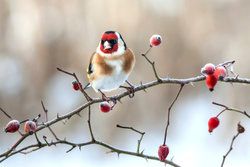
In my previous blogpost, I promised that I would be providing answers to the questions my students and clients posed about winter/Christmas-related language and culture. Some of you might have found it useful to use those questions in the classroom, some of you might have found it interesting to test yourself with those questions, and some might just find that such trivia add to the festivities.
Whatever the reasons you have for reading this blogpost, I hope you find the answers as interesting as I do.
1. What are gale force winds? What about wind chill factor?
A gale is a very strong wind measuring 50 to 102 km/h or of force 7 to 10 on the Beaufort Scale. Gale force winds are therefore very strong winds.
Wind chill factor is the perceived decrease in temperature felt by the human body due to the flow of air. So, the air temperature might be 5 degrees Celsius, but the wind chill numbers are lower, increasing the rate of heat loss and the air feels colder because of the chilling effect of the wind on the skin.

2. What is the difference between a blizzard and a snow storm?
A snow storm is where large amounts of snow falls, causing problems with traffic and transport. A blizzard is a severe snow storm where winds are at least 56km/h and last for more than 3 hours.
3. What is a snow angel? Is it an angel that comes to protect you?
A snow angel is not a real angel but a design created in the snow by lying down in it and moving one’s arms and legs up and down. The result is the shape of what looks like an angel.

4. What is the difference between a heater and a radiator?
Heaters tend to refer to electric powered heaters that rely on heating elements like wire, ribbon, or quartz, that produce an orange glow when activated and produce directional heat.
Radiators use hot water, or sometimes steam, that is heated up by a central boiler and circulated by pumps through the radiators. Heat is transferred via convection and diffused.
5. Can you show us where the different parts of the fireplace are according to this picture? : The hearth, the flue, the furnace, the mantelpiece? And what are grates, bellows and pokers?
I could start trying to draw and explain these terms to you, but it might be easier if you look at Wikipedia’s fantastic explanations.
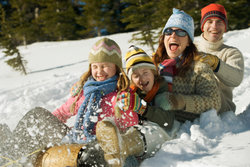
6. What is the difference between a bobsled, a sleigh and a toboggan?
According to most dictionaries, a sled, a sleigh and a sledge are basically the same things. They refer to a carriage mounted on runners instead of wheels and used for travelling over snow or ice. A sled or sleigh can be towed along or drawn by horses (or reindeer).
A bobsled is a long narrow sled built for speed and can accommodate up to two, often used for racing.
And a toboggan is a flat sled usually made of wood, has an even surface, is turned up in the front and has limited steering ability.
7. What is the difference between gloves and mittens?
Gloves insulate each finger individually and therefore provide more dexterity. Mittens do not have separate finger openings except for the thumb.
8. What is horizontal rain?
Horizontal rain is said to happen when the wind is so strong that it starts to look like the rain is falling horizontally, but of course the rain is not actually falling in a perfect horizontal line.
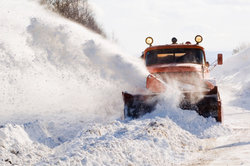
9. What is a snowplow?
A snowplow is a device that looks like a big blade mounted on a vehicle and used to remove snow and ice on the road. It is also a skiing technique taught to beginners to help them break where the front tips of the skis are brought together and the tails are pushed wide apart.
10. What does is mean to ‘grit the road’?
When the roads are icy and covered in snow, it can be dangerous to both vehicles and pedestrians. Gritting the road means to spread a layer of salt and grit on the road surfaces. The salt helps the ice to melt and the grit provides more friction between tires and the roads.
11. When and what is the winter solstice?
Usually on Dec 21st or 22nd, the winter solstice marks the shortest day and the longest night of the year.
12. What did my host family mean when they said the weather is ‘dreary’?
‘Dreary weather’ is synonymous with ‘dismal weather’ or ‘bleak weather’ or ‘miserable weather’. It is a negative way of saying that the weather is wet, gloomy and depressing.
13. Why can’t I say, “The weather is getting a bit nippy, innit?”
The word ‘nippy’ has a ‘posh register’ and is used often by the upper classes to mean ‘chilly’. The word ‘innit?’ is a generic question tag and the colloquial version of ‘isn’t it?’ and is used as a slang among certain groups of the working classes. The clash in register makes this sentence sound rather odd.

14. What collocates with tobogganing? Do we say ‘to do tobogganing’ or ‘to go tobogganing’?
We would say ‘go tobogganing’ rather than ‘do tobogganing’. However, according to the BYU-BNC corpus, the most common verbs to collocate with ‘tobogganing’ are ‘enjoy’, ‘took’ and ‘like’. More often, ‘tobogganing’ is used alongside a list of other winter sports e.g. ‘They offer skating and tobogganing.’
15. We can say ‘gusty winds’ but can we say ‘gusty rain’?
‘Gusty’ refers to strong winds blowing and not rain. The typical collocations are ‘gusty winds’ and ‘gusty (weather) conditions’.
16. What colligates with ‘sleet’ and ‘hail’? We can use ‘rain’ as a verb and noun and as a verb, we often use the present continuous, as in ‘it is raining’. Can we do that with ‘sleet’ and ‘hail’ too? Can we say ‘It is sleeting’? ‘It sleets often in London’? ‘It sleeted all over my street yesterday’? What about ‘It is hailing’? and ‘It doesn’t hail often in my country’?
Although the dictionary allows ‘sleet’ as a noun and a verb, the BYU-BNC corpus shows more than a hundred examples of sleet being used as a noun and only five examples of sleet used in the progressive tense: ‘It was sleeting’ and two examples of ‘sleeting’ used as an adjective in ‘sleeting showers’ and ‘sleeting night rain’. There was only one example of the verb sleet used in the past tense ‘It sleeted and rained’.
Like ‘sleet’, ‘hail’ is listed in the dictionaries as both a noun and a verb, but the corpus data seems to show the noun ‘hail’ used a lot more often than the verb e.g. ‘hail and thunder’, ‘rain, hail and snow’, ‘a hail of ~’ and the compound ‘hail storms’. It was practically impossible to find ‘hailing’ used in the progressive tense (with the meaning of a weather condition).
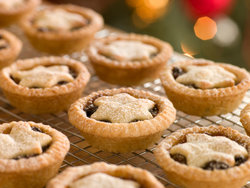
17. What are mince pies? They have fruit in them and not mince meat. So why are they called mince pies?
A mince pie is a small fruit-based sweet pie usually served at Christmas in Britain. In Tudor England, mince pies were made from shredded meat, dried fruit and suet, mixing sweet and savoury foods. As it was derived from an old Roman custom and associated with the Vatican, mince pies were banned alongside other Catholic goods during the English civil war. The mince pie evolved through the ages and today, the modern mince pie is made of dried fruit, suet, apples, and spices like nutmeg and cinnamon and no longer includes the savoury ingredients.
18. Why are pantomimes associated with Christmas?
Pantomimes are a typically English musical comedy stage production usually seen at Christmas/New Year’s. Developed via a long history of European and English theatre, modern pantomime includes songs, dancing, slapstick comedy and lots of audience participation, and often uses traditional stories like fairy tales as their main narrative.
Now a firm British institution, going to pantomimes is part of many families’ traditional Christmas outings.
19. Why do we have Brussels sprouts in Christmas dinners when nobody eats them?
In the United Kingdom and Ireland, Christmas dinners usually include roast turkey, stuffing, roast potatoes and some boiled vegetables like parsnips and Brussels sprouts. Looking like miniature cabbages, they are sometimes slightly bitter in taste and not the most popular of vegetables. However, they are especially high in Vitamin C and are a good source of many essential vitamins, fibre and folate.
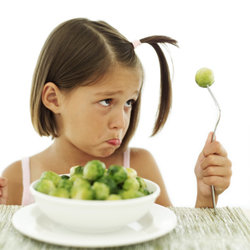
20. What is in Christmas pudding? Why did little Jack Horner stick his thumb in one?
Christmas pudding aka plum pudding is often served as a dessert at the end of Christmas dinner. In the 14th century, it used to be a porridge-like consistency made from beef, mutton, dried fruits and spices. In the 1600s, it started to evolve into more of a raisin-based pudding, and in 1714, King George I, who loved the taste of Christmas pudding, established it as part of the Christmas meal. The ingredients include dried fruits, egg, suet, and a range of spices like cinnamon, nutmeg, cloves and ginger. These days, Christmas pudding is often served with cream, brandy butter, custard or even lemon cream.
Those familiar with the nursery rhyme ‘Little Jack Horner’ would know this:
Little Jack Horner
Sat in the corner
Eating his Christmas pie
He stuck in his thumb and
Pulled out a plum and
Said what a good boy am I!
But they might not know that it has been suggested that Jack Horner was referring to Thomas Horner, a steward to the then abbot of Glastonbury. The abbot sent Thomas to London with a pie for King Henry the 8th, and in the pie were deeds to a dozen manors in England meant to be used as a bribe to convince the King not to nationalize the church lands. Rumour has it that Thomas the opportunist extracted one of those deeds and kept them for himself, thus ‘he stuck in his thumb and pulled out a plum’.
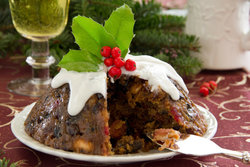
21. Is mistletoe and the associated kissing tradition typically American? If you hung a mistletoe in England and stood under it, would anyone kiss you?
The Druids believed in the mystical powers of mistletoe but its modern day relationship to love, friendship and kissing comes from Norse mythology. However, the tradition of kissing under the mistletoe was later found in England and spread to America. These days, the tradition holds true for most people in the UK and America, but is not taken particularly seriously.
 22. What is Boxing Day and why is it named after such a violent sport?
22. What is Boxing Day and why is it named after such a violent sport?
Boxing Day falls on the 26th December, the day after Christmas. It is often a bank/public holiday in the UK, Australia, New Zealand, and other Commonwealth nations. No one can say for sure why it is named Boxing Day, but some say it is because servants of a household would receive their Christmas presents and bonuses in a ‘Christmas box’ the day after Christmas, when they would be allowed to visit their own families. Others say it is connected to the alms box in church that is used to collect donations for the poor.
Boxing Day is called ‘St Stephen’s Day’ in Ireland, Italy and Finland, and the ‘Day of Goodwill’ in South Africa.
23. Why does my friend in Cornwall say that she has Christmas dinner is at 1pm while my friends in London insist that Christmas dinner is held at 7pm?
In most part of the English-speaking world, dinner refers to the evening meal and usually takes place at about 6/7pm. However, dinner traditionally refers to the biggest/main meal of the day and today. In some parts of England, dinner refers to the afternoon meal that usually takes place at 12/1pm, while the evening meal is called tea or supper.
Therefore, depending on where you are in the United Kingdom, Christmas dinner might be held at a different time of the day.
So, whichever part of the world you are in and whatever time you will be having your Christmas dinner, I hope you have fun, enjoy your Christmas pudding, and try and eat those Brussels sprouts!
Happy Holidays!
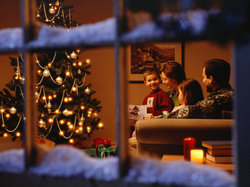


Comments
Write a Comment
Comment Submitted